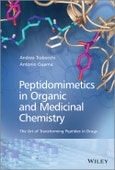A peptidomimetic is a small protein-like chain designed to mimic a peptide with adjusted molecular properties such as enhanced stability or biological activity. It is a very powerful approach for the generation of small-molecule-based drugs as enzyme inhibitors or receptor ligands.
Peptidomimetics in Organic and Medicinal Chemistry outlines the concepts and synthetic strategies underlying the building of bioactive compounds of a peptidomimetic nature. Topics covered include the chemistry of unnatural amino acids, peptide- and scaffold-based peptidomimetics, amino acid-side chain isosteres, backbone isosteres, dipeptide isosteres, beta-turn peptidomimetics, proline-mimetics as turn inducers, cyclic scaffolds, amino acid surrogates, and scaffolds for combinatorial chemistry of peptidomimetics. Case studies in the hit-to-lead process, such as the development of integrin ligands and thrombin inhibitors, illustrate the successful application of peptidomimetics in drug discovery.
Table of Contents
Preface xiiiAbbreviations xvii
PART I The Basics of Peptidomimetics 1
1. The Basics of Peptidomimetics 3
1.1 Introduction 3
1.2 Definition and Classification 5
1.3 Strategic Approaches to Peptidomimetic Design 7
1.3.1 Modification of Amino Acids 8
1.3.2 Compounds with Global Restrictions 9
1.3.3 Molecular Scaffolds Mimicking the Peptidic Backbone 10
1.4 Successful Examples of Peptidomimetic Drugs 12
1.4.1 ACE Inhibitors 13
1.4.2 Thrombin Inhibitors 13
1.5 Conclusion 16
References 16
2. Synthetic Approaches towards Peptidomimetic Design 19
2.1 Introduction 19
2.2 Local Modifications 20
2.2.1 Single Amino Acid Modifications 23
2.2.2 Dipeptide Isosteres 26
2.2.3 Retro-inverso Peptides 29
2.2.4 N-Methylation of Peptides 30
2.2.5 Azapeptides 31
2.2.6 Peptoids 31
2.3 Global Restrictions through Cyclic Peptidomimetics 32
2.4 Peptidomimetic Scaffolds 34
2.5 Conclusions 35
References 35
PART II Synthetic Methods and Molecules 37
3. Peptidomimetic Bioisosteres 39
3.1 Introduction 39
3.2 Peptide Bond Isosteres 40
3.2.1 Thioamides 41
3.2.2 Esters 41
3.2.3 Alkenes and Fluoroalkenes 41
3.2.4 Transition-State Isosteres 42
3.3 Side-Chain Isosteres 45
3.3.1 Guanidine Isosteres in Arginine Peptidomimetics 45
3.3.2 Isosteres of Aspartic Acid and Glutamic Acid 49
3.3.3 Tethered α-Amino Acids: Constraining the χ-Space 53
3.4 Dipeptide Isosteres 59
3.4.1 δ-Amino Acids 63
3.5 Tripeptide Isosteres 67
3.6 Conclusion 68
References 69
4. Solid-Phase Synthesis and Combinatorial Approaches to Peptidomimetics 75
4.1 Introduction 75
4.2 Solid-Phase Synthesis of Peptidomimetics 76
4.2.1 Scaffolds from α-Amino Acids 76
4.2.2 Scaffolds from Amino Aldehyde Intermediates 85
4.2.3 Pyrrolidine-Containing Scaffolds 89
4.3 Conclusion 94
References 95
5. Click Chemistry: The Triazole Ring as a Privileged Peptidomimetic Scaffold 99
5.1 Introduction 99
5.1.1 CuAAC Reaction 100
5.1.2 Triazole Ring as a Peptidomimetic Isostere 101
5.2 Triazole-Containing Peptidomimetics Elaborated through ‘Click Chemistry’ 102
5.2.1 Macrocycles 102
5.2.2 Oligomers and Foldamers 107
5.3 Relevant Applications in Drug Discovery 110
5.3.1 AChE Inhibitors 110
5.3.2 HIV Protease Inhibitors 111
5.3.3 MMP Inhibitors 114
5.3.4 Integrin Ligands 115
5.4 Conclusions 118
Acknowledgements 119
References 119
6. Peptoids 123
6.1 Introduction and Basics of Peptoids 123
6.2 Synthetic Methods 126
6.3 Macrocyclic Peptoids 129
6.4 Conformational Analysis of Folded Peptoids 130
6.5 Application of Peptoids as Antimicrobial Peptidomimetics 132
6.6 Conclusions 134
References 134
7. Sugar Amino Acids 137
7.1 Introduction 137
7.2 α-SAAs 138
7.2.1 Furanoid α-SAAs 138
7.2.2 Pyranoid α-SAAs 142
7.3 β-SAAs 144
7.3.1 Furanoid β-SAAs 144
7.3.2 Pyranoid β-SAAs 147
7.4 γ-SAAs 148
7.5 δ-SAAs 150
7.5.1 Furanoid δ-SAAs 150
7.5.2 Pyranoid δ-SAAs 154
7.6 Representative Applications in Medicinal Chemistry 159
7.7 Conclusions 162
References 162
8. Cyclic -Amino Acids as Proline Mimetics 165
8.1 Introduction 165
8.2 Cyclic α-Amino Acids 166
8.2.1 3-Substituted Proline Derivatives 167
8.2.2 4-Substituted Proline Derivatives 168
8.2.3 5-Substituted Proline Derivatives 169
8.2.4 Other Heterocyclic Proline Analogues 171
8.3 Bicyclic α-Amino Acids 174
8.3.1 β/γ-Ring Junction 175
8.3.2 α/γ-Ring Junction 178
8.3.3 γ/δ-Ring Junction 179
8.3.4 α/δ-Ring Junction 180
8.3.5 β/δ-Ring Junction 182
8.3.6 N/β-Ring Junction 183
8.3.7 Pipecolic-Based Bicyclic α-Amino Acids 183
8.3.8 Morpholine-Based Bicyclic α-Amino Acids 187
8.4 Conclusions 189
References 189
9. -Turn Peptidomimetics 191
9.1 Introduction 191
9.2 Definition and Classification of β-Turns 192
9.3 Conformational Analysis 194
9.4 β-Turn Peptidomimetics 196
9.4.1 Proline Analogues in β-Turn Peptidomimetics 197
9.4.2 δ-Amino Acids as Reverse-Turn Inducers 200
9.4.3 Molecular Scaffolds as β-Turn Peptidomimetics 209
9.5 Conclusions 214
References 215
10. Peptidomimetic Foldamers 219
10.1 Introduction 219
10.2 Classification 220
10.3 Peptoids 221
10.4 β-Peptides: First Systematic Conformational Studies 221
10.5 Hybrid Foldamers 226
10.6 From Structural to Functional Foldamers 227
10.6.1 Peptoids as Foldameric Antimicrobial Peptidomimetics 227
10.6.2 Foldamers Targeting Bcl-xL Antiapoptotic Proteins 227
10.7 Conclusions 228
References 228
PART III Applications in Medicinal Chemistry 231
11. Case Study 1: Peptidomimetic HIV Protease Inhibitors 233
11.1 Introduction 233
11.2 The HIV-1 Virus 233
11.2.1 HIV-1 Protease 234
11.3 Antiretroviral Therapy 238
11.4 Drug Resistance 239
11.4.1 Mechanisms of Resistance to Protease Inhibitors 239
11.5 HIV-1 Protease Inhibitors 240
11.5.1 Transition-State Analogues 240
11.5.2 Peptidomimetic Drugs 241
11.5.3 Next-Generation Cyclic Peptidomimetic Inhibitors 245
11.6 Conclusions 255
Acknowledgements 255
References 256
12. Case Study 2: Peptidomimetic Ligands for Integrin 259
12.1 Introduction 259
12.2 Peptide-Based Peptidomimetic Integrin Ligands 262
12.3 Scaffold-Based Peptidomimetic Integrin Ligands 270
12.4 Conclusions 280
References 280
Index 283








